
A kitchen is a room or part of a room used for cooking and food preparation in a dwelling or in a commercial establishment. A modern middle-class residential kitchen is typically equipped with a stove, a sink with hot and cold running water, a refrigerator, and worktops and kitchen cabinets arranged according to a modular design. Many households have a microwave oven, a dishwasher, and other electric appliances. The main functions of a kitchen are to store, prepare and cook food. The room or area may also be used for dining, entertaining and laundry. The design and construction of kitchens is a huge market all over the world.

Grilling is a form of cooking that involves dry heat applied to the surface of food, commonly from above, below or from the side. Grilling usually involves a significant amount of direct, radiant heat, and tends to be used for cooking meat and vegetables quickly. Food to be grilled is cooked on a grill, using a cast iron/frying pan, or a grill pan.

Cookware and bakeware is food preparation equipment, such as cooking pots, pans, baking sheets etc. used in kitchens. Cookware is used on a stove or range cooktop, while bakeware is used in an oven. Some utensils are considered both cookware and bakeware.

Outdoor cooking is the preparation of food in the outdoors. A significant body of techniques and specialized equipment exists for it, traditionally associated with nomadic cultures such as the Berbers of North Africa, the Arab Bedouins, the Plains Indians, pioneers in North America, and indigenous tribes in South America. These methods have been refined in modern times for use during recreational outdoors pursuits, by campers and backpackers.
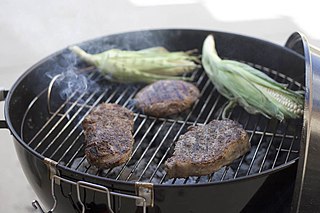
A barbecue grill or barbeque grill is a device that cooks food by applying heat from below. There are several varieties of grills, with most falling into one of three categories: gas-fueled, charcoal, or electric. There is debate over which method yields superior results.
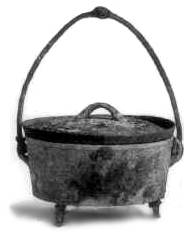
A Dutch oven is a thick-walled cooking pot with a tight-fitting lid. Dutch ovens are usually made of seasoned cast iron; however, some Dutch ovens are instead made of cast aluminium, or ceramic. Some metal varieties are enameled rather than being seasoned, and these are sometimes called French ovens. Dutch ovens have been used as cooking vessels for hundreds of years. They are often called casserole dishes in some English-speaking countries other than the United States, and cocottes in French. They are similar to both the Japanese tetsunabe and the sač, a traditional Balkan cast-iron oven, and are related to the South African potjie, the Australian Bedourie oven and Spanish cazuela.

Bedourie is a town and a locality in the Shire of Diamantina, Queensland, Australia. In the 2016 census, Bedourie had a population of 122 people.

An oven is a tool which is used to expose materials to a hot environment. Ovens contain a hollow chamber and provide a means of heating the chamber in a controlled way. In use since antiquity, they have been used to accomplish a wide variety of tasks requiring controlled heating. Because they are used for a variety of purposes, there are many different types of ovens. These types differ depending on their intended purpose and based upon how they generate heat.

A kitchen stove, often called simply a stove or a cooker, is a kitchen appliance designed for the purpose of cooking food. Kitchen stoves rely on the application of direct heat for the cooking process and may also contain an oven, used for baking. "Cookstoves" are heated by burning wood or charcoal; "gas stoves" are heated by gas; and "electric stoves" by electricity. A stove with a built-in cooktop is also called a range.

Le Creuset is a French maker of cookware. They are best known for producing enameled cast-iron cookware. The company first manufactured their products in the town of Fresnoy-le-Grand in France in 1925, which are similar in function to a Dutch oven but with T-shaped handles designed by the Italian industrial innovator Enzo Mari. The Le Creuset Dutch oven is on display in the Smithsonian Institution's National Museum of American History in Washington, D.C. as a part of the recreation of the chef Julia Child's kitchen. It has been widely reported to be her favorite cooking pot, though specialist sources hold that it was the Dutch oven of Le Creuset's less-remembered competitor Descoware that was her real favorite. The company also makes many other types of cookware and bakeware, from fondue-sets to tagines.

An earth oven, ground oven or cooking pit is one of the simplest and most ancient cooking structures. At its most basic, an earth oven is a pit in the ground used to trap heat and bake, smoke, or steam food. Earth ovens have been used in many places and cultures in the past, and the presence of such cooking pits is a key sign of human settlement often sought by archaeologists. Earth ovens remain a common tool for cooking large quantities of food where no equipment is available. They have been used in various civilizations around the world and are still commonly found in the Pacific region to date.

Heavy-duty cookware made of cast iron is valued for its heat retention, durability, ability to maintain high temperatures for longer time duration, and non-stick cooking when properly seasoned. Seasoning is also used to protect bare cast iron from rust. Types of cast iron cookware include frying pans, dutch ovens, griddles, waffle irons, flattop grills, panini presses, crepe makers, deep fryers, tetsubin, woks, potjies, and karahi.
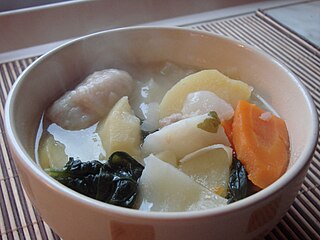
Boil up is a traditional Māori food from Aotearoa New Zealand.
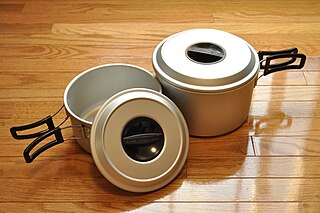
Cooker may refer to several types of cooking appliances and devices used for cooking foods.

A kitchen utensil is a small hand held tool used for food preparation. Common kitchen tasks include cutting food items to size, heating food on an open fire or on a stove, baking, grinding, mixing, blending, and measuring; different utensils are made for each task. A general purpose utensil such as a chef's knife may be used for a variety of foods; other kitchen utensils are highly specialized and may be used only in connection with preparation of a particular type of food, such as an egg separator or an apple corer. Some specialized utensils are used when an operation is to be repeated many times, or when the cook has limited dexterity or mobility. The number of utensils in a household kitchen varies with time and the style of cooking.
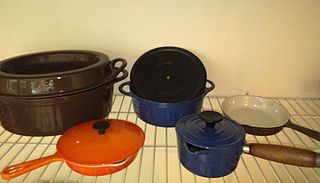
Cousances was the brand of enameled cast iron cookware. originally manufactured by a foundry in the town of Cousances-les-Forges in northeastern France. The Cousances foundry began making cast iron pans in 1553. Four centuries later, in 1957, the brand was acquired by Le Creuset. Cookware under the Cousances brand continued to be manufactured by Le Creuset into the early 1980s.
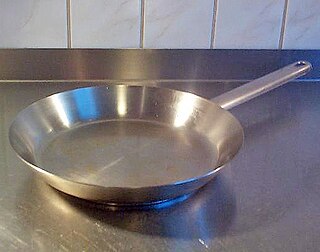
A frying pan, frypan, or skillet is a flat-bottomed pan used for frying, searing, and browning foods. It is typically 20 to 30 cm in diameter with relatively low sides that flare outwards, a long handle, and no lid. Larger pans may have a small grab handle opposite the main handle. A pan of similar dimensions, but with less flared, more vertical sides and often with a lid, is called a sauté pan. While a sauté pan can be used as a frying pan, it is designed for lower heat cooking.

Seasoning or curing is the process of coating the surface of cookware with a bioplastic formed from heated fat or oil in order to produce a heat, corrosion, and stick resistant hard coating. It is required for cast-iron cookware and carbon steel, which otherwise rust rapidly in use, but is also used for many other types of cookware, as it helps prevent food sticking.

















